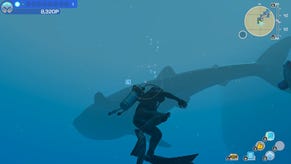Retrospective: Another Code - Two Memories
Remember this?
The DS has reflective screens. You know this because you've tried to play outside on a sunny day. But here it's to your advantage. If you angle the screens correctly, such that a key on one screen is reflected into the outline of a book on the other, then the odd white lines align to form a letter and a number. And it reflects them incredibly clearly. It's a joyful moment.
The second is even better. As you explore the mansion D begins to remember a female friend his own age, Franny. When you find her bedroom inside you discover her sketchbook of woodprints. One is incomplete. Elsewhere in the room are two wooden prints. Use them from your inventory with the sketchbook and their patterns appear on the top screen, the page on the bottom screen. What to do?
The first time I encountered this puzzle I remember being frustrated at not knowing what to do next. I remember even stupidly tapping the top screen with the stylus (we've all done it). And then the thought occurred. It's a print, right. And there's the print blocks on the top, the pad on the bottom. And my DS has a hinge. Surely not?
It works. It's so exciting that it works. Replaying it now five years later, having somehow forgotten most of the plot, this puzzle was unforgettable. But even now the moment of closing the DS (an act we associate with pausing a game, saving DS battery life, that sort of thing) being subverted into being a game mechanic is thrilling. A means of interaction within the game world by manipulating a device in the real world.

There are many other smart themes appearing. A favourite is D's fractured memories appearing to him in the form of pencil-sketched concept art. It's a theme Cing would go on to elaborate upon enormously in Hotel Dusk, but its brief, subtle use here is clever and effective. There are, however, some really damned stupid ideas too.
The English comprehension tests, for instance. At the end of each chapter Ashley insists on remembering everything that's just happened in the form of multiple-choice questions.
John described this idea as:
a) very clever
b) damned stupid
c) photosynthesis
No thanks. I'm not 10. Oh, and choosing to have the 'back' button make a farting noise doesn't lend appropriate gravitas to scenes about the deaths of loved ones.
It's a peculiarly bleak story. Especially when you consider that it's played from the perspective of a 13-year-old. Murder, betrayal, lies, suicide and kidnapping, spanning multiple generations and two timelines. And while D's story is clumsily told, with a meandering family tree that's quickly muddled, there's plenty going on despite the brevity.
Four and a half hours (4:26 to be precise, according to my end-game save) is clearly not long enough for any game. And especially not when any amount of that is taken up by a sliding-tile puzzle. But Another Code still feels worth returning to (although tough to find at a decent price). If anything it is a portent of the possibilities adventure gaming could have on the DS, if only anyone else had bothered to be so imaginative in the half-decade since.
Cing's Again is due to appear in North America on DS next month, and while there's no translated release date for Hotel Dusk sequel Last Window it's reasonably likely we'll see one. So it's good to know that at least one developer is willing to keep pushing at it, despite varying success. When a few of the good ideas are truly great, it can carry a game a long way.





.jpg?width=291&height=164&fit=crop&quality=80&format=jpg&auto=webp)
_Rwmp6uD.jpg?width=291&height=164&fit=crop&quality=80&format=jpg&auto=webp)

